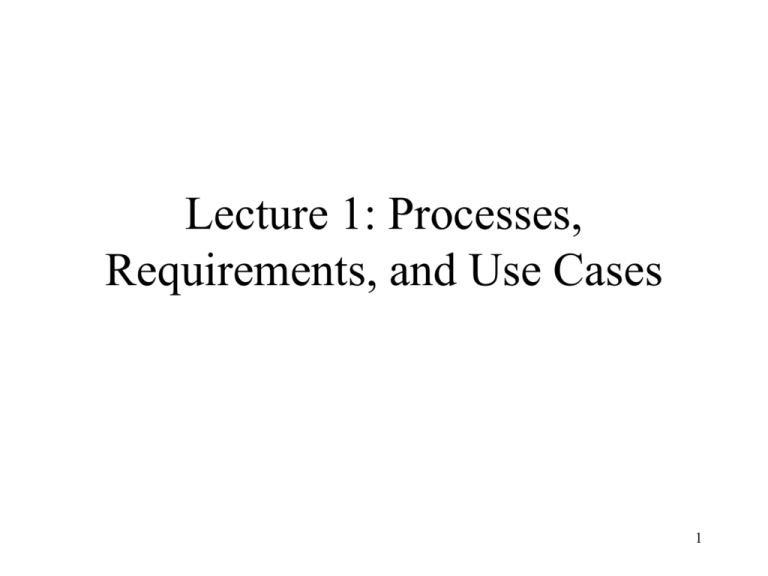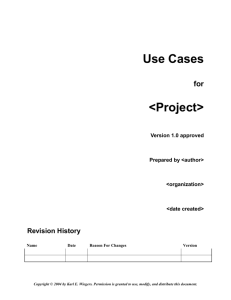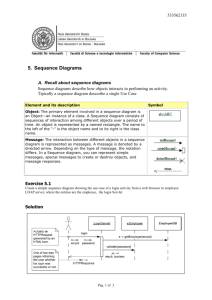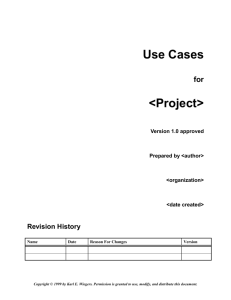ppt
advertisement

Lecture 1: Processes, Requirements, and Use Cases 1 Development Processes • Early Days: evolve a system – Build and fix – Leads to chaos – Need for intelligent design • Waterfall Model – Requirements, Design, Code, Tests, Maintenance 2 Rational Unified Process • Iterative, incremental development: – Development cycle: results in a release – Iteration phases: Inception, Elaboration, Construction, Transition – Phase activities: Business Modeling, Requirements, Design, Implementation, Test, Deployment, Configuration & Change, Project Management, Environment (tools, process design) 3 Factors for Success and the RUP • Iterative development: develop part of the functionality, explore designs such as GUI • Daily builds: incorporate new code into (partially) complete system; rapid feedback via testing • Team experience in shipping multiple products • Early focus on building and evaluating a cohesive system architecture • (Product Development Practices that Work, MIT Sloan Management Review, 42:2, 2001) 4 Lightweight vs Heavyweight Process • Formal, heavyweight: strict phases with defined formal documentation, often not iterative • Agile: adjust to application, activities in one phase differently weighted • Extreme programming: smaller projects, all staff eye to eye, paired programming, tests as specifications -> little formal documentation other than code 5 Introduction to Requirements • Basic but not sole step in inception • Types of requirements: FURPS – – – – – Functionality Usability Reliability Performance Supportability 6 Some OO Terminology • Responsibility – function that must be performed. E.g. hiring personal, searching a data base for a record • Role – abstract entity that performs the role – E.g. project leader, DB class • Actor – concrete entity that plays a role to fulfill some responsibility. E.g. Fred Bloggs, DB class instance 7 Actors and RUP • External object that interacts with system - external = assumed, already given • Causes input events, receives output • Examples from POS: cashier, customer, product info database (assumed external) 8 Use Cases • Story of system usage, basic RUP requirements method; Functionality aspect of requirements • Scenario: Specific use of a system, interaction between actors and system • Use case: collection of related scenarios • Use case documentation – Individual use cases: tables, paragraphs – Actors / Use case interactions: use case diagrams 9 Use Case Table - Example Dater System responsibility 1. Log in 2. Determine valid 3. Display dater menu 5. Display criteria input form 7. Find date 8. Display date data 4. Choose get-date 6. Enter prefs 7. Logs out 10 Paragraph Style - Sections • • • • • • • • • • Primary Actor(s) Stakeholders and interests Preconditions Postconditions Happy Case Alternative Cases Special Requirements Variations (technology, data) Frequency Open Issues 11 Stakeholders • Developers, users, marketing, customers, regulators • Use case describes part of contract between stakeholders and developers • E.g. Dating system – daters, administrator, developers 12 Pre-conditions and Postconditions • Preconditions – What we will assume to be true before a system use • Postconditions – What we guarantee to be true afterwards • Contracts: pre and post conditions 13 Happy Cases • Main Flow: normal or main flow of control in a use case • Alternatives: minor success flows, error flows, exceptions – Branches or subcases of main flow – Refinements of abstract functionality 14 Finding Use Cases • Not single steps, not whole complex processes. – E.g. Dating system: not log on, not DS usage, but Dater Asks for a Date • Elementary Business Process • Abstract from concrete to intentional – E.g. • concrete: enter card, enter PIN • intentional: user identifies himself • Use cases satisfy user/actor goals 15 Finding Actors/Roles • Types of Actors – Primary, supporting, and offstage actors • MetaRoles: system initiation and termination, updates • Events and who causes them 16 Use Case Diagrams • Show actors/roles and use cases they interact with • Shows relationships between use cases – Alternative subcases • e.g. administrator updates DS database – Delete a member, Add a member – Uses subcase • e.g. member/administrator uses system – Log on sub use case – Data-base component 17 Sample Use Case Diagram 18 Tips • Do not get caught up constructing Use Case Diagrams • Use intentional use cases during requirements, concrete during design • Avoid tables if they are too restrictive • Accept that inception use cases will be incomplete or some will lack detail 19 System Increments • System increments Horizontal: one layer or tier at at time Vertical: one or more “threads” or complete functional uses • Use Cases and system increments – Choose a subset of the uses cases 20 Use Cases and System Increments • Initial and subsequent increments • Selection Factors – Risk: of remaining, are some complex, ambiguous, uncertain usability – Coverage: want to touch on all major functionality in early iterations, principal data flows, happy cases – Criticality: critical to business enterprise – Architectural: start up, stripped down vertical functionality 21 DS Use Case Groupings • Use cases by class of user – Member – Administrator – Unauthorized user • Use case by member user functionality – GetADate – SetMemberData 22 DS First Increment Choice • Use Case: member logs on and asks to get a date, system returns a date from DB or reports no date present • Rationale – Criticality – Coverage • Missing supporting functionality – Administrator enters members – Members enter their properties – Will need to preload the DB with data 23





